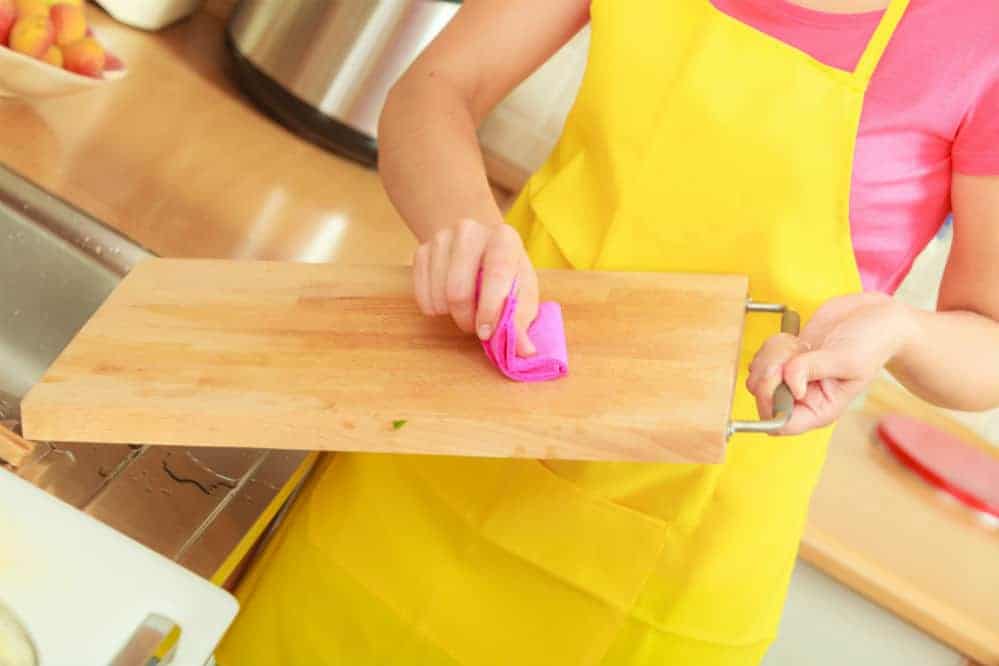This post contains affiliate links. As an Amazon Associate I earn from qualifying purchases
Up to now, there are still people who create a fuss about a person who uses separate chopping boards for meat and vegetables. It is not being overprotective or paranoid, but it is actually the most logical way of protecting their loved ones from acquiring food-borne diseases. Also, cleaning these cutting boards should not be taken lightly, so it is crucial that one knows how to clean wood cutting board after raw meat has been sliced on it.
Table of Contents
How Dirty Are Chopping Boards?
Did you know that there is a dirtier spot in the house than the toilet seat? It may not seem like it but chopping boards, either wood or plastic, are twice dirtier than the toilet seat at home. These microorganisms can cause serious illnesses and even death. The most common of them are Salmonella, E-coli, and Campylobacter. Depending on one’s immunity, he or she may experience diarrhea, vomiting, and stomach discomforts, which may then lead to dehydration and other complications. Nevertheless, all those can be avoided by proper cleaning of chopping boards after every use.
How to Clean Raw Meat from a Wooden Cutting Board
Cleaning of wooden cutting boards falls into two categories, which are regular cleaning and deep cleaning.
Regular Cleaning
Here are the steps in cleaning your cutting boards right after you cut or slice raw meat.
1. Wash
The first step to cleaning wood cutting boards is by washing them. Yes, this is just the first step since it is not enough to just clean them. If you want them really safe for the family, there are other precautionary measures that you need to follow.
The most important one is to use gentle soap and water. Ordinary dishwashing soaps may make the wooden fibers or your chopping board weak, so it is better to use gentle soap and water such as the one used for washing the hands. The second thing to consider is that you should not use cloth. Using a cloth that is also normally used to clean other utensils would only spread these germs.
Like chopping boards, kitchen cloth is also one of the dirtiest tools in the house, so it is suggested you use something disposable or one that is used for this purpose only. You may also opt to use your bare hands.
2. Rinse with Hot Water
It is a common knowledge that hot water can kill bacteria but do note that sometimes, this would not be enough to disinfect the chopping boards completely. In addition, never soak your wooden chopping board in hot water or any kind of water for that matter, as it may cause the wood to expand.
3. Wipe with Vinegar
After washing the wooden chopping boards and making sure that all food debris is removed, it is also a good idea to wipe the surface of the board with full-strength vinegar. Vinegar has acetic acid that kills bacteria, and it can help deodorize the wooden chopping board.
Deep Cleaning
Deep cleaning involves making sure that there is no food debris stuck between the cuts and cracks of the wooden cutting board. This can be done by creating baking soda and salt paste (just add water to salt or baking soda) and scrubbing it against the surface of the chopping board by hand.
Other Wooden Chopping Board Maintenance Techniques
Cleaning your wooden chopping board is not enough since it is continuously exposed to meat, which can be a growth haven for microorganisms.
1. Sanitizing
In terms of disinfecting and purifying your cutting boards, you can go the conservative route or the aggressive route. For the conservative method, apply hydrogen peroxide on the surface of the wooden board right after applying vinegar. Even three percent (3%) peroxide would do the trick.
On the other hand, for the aggressive method, you may opt to use regular bleach with water (one teaspoon of bleach to two liters of water). Scrub in a circular motion for a while, then rinse with running water or wipe with a damp paper towel.
2. Odor Removal
Several ingredients can remove the odor from wooden cutting boards including salt, baking soda, and vinegar, but most people prefer lemon. To do so, cut a lemon in half and scrub the inner part of the sliced lemon against the surface of the wooden board. That way, the strong odors including those of onion and garlic can be neutralized.
3. Brightening
For people who really love cooking and all their kitchen tools, a little brightening may be required. You can use mineral oil, walnut oil, pure Tung oil, almond oil, or beeswax, and this can be done once a month. Make sure to avoid other oils that because some oils become rancid quickly.
To do so, apply the oil until the wooden cutting board completely absorbs it.
3. Drying
Whether washing, sanitizing, or brightening, it is important that wooden cutting boards are air dried afterward. Bacteria thrive in a moist environment, so place the chopping board somewhere that there is an excellent air circulation. You can let it hang dry or leave it leaning against a firm surface. The important thing is the whole board is exposed to air.
It is also an option to wipe the wood cutting boards dry by using a lint-free cloth. Note that at this point, they have already been cleaned thoroughly and disinfected; otherwise, using cloth is still discouraged. When wiping the chopping board with cloth, make sure to rub it in the direction of the wood grain to avoid leaving any cloth debris on it.
When to Replace Your Wooden Cutting Board?
When was the last time you replaced your chopping board? Did you know that it is recommended that they are replaced at most every five years most especially if you cook a lot? The more and deeper cuts and cracks there are on your wooden chopping board, the riskier it is for your loved ones.
Conclusion
At this point, you may still have not yet gotten over the fact that your chopping boards at home are dirtier (and yuckier) than toilet seats. Thus, it is important to remember the instructions on how to clean wood cutting board after raw meat by heart.
Remember to wash it either with gentle soap and water, or with vinegar by hand (do not use kitchen cloths or sponge when cleaning the board), deep clean it with baking soda paste, disinfect it with hydrogen peroxide or bleach, remove its foul odor with lemon, brighten it with selected oils or beeswax, air dry it, and replace it when it already has too many cracks and cuts.
By doing all those, you not only keep your family safe, but you also make your favorite kitchen tool looking and smelling clean and fresh.

